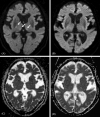Left Hemiplegia Possibly Due to Glucose Reperfusion Injury after Recovery of Severe Hypoglycemia in a Woman with Type 2 Diabetes Mellitus
- PMID: 34393160
- PMCID: PMC8907763
- DOI: 10.2169/internalmedicine.7202-21
Left Hemiplegia Possibly Due to Glucose Reperfusion Injury after Recovery of Severe Hypoglycemia in a Woman with Type 2 Diabetes Mellitus
Abstract
A 79-year-old woman with type 2 diabetes receiving insulin was rushed to our hospital due to severe hypoglycemia. Glucose was administered, and the consciousness disturbance was promptly improved. A few hours later, conjugate deviation of the eyes to the right and left hemiplegia occurred at a normal glucose level. Cerebral magnetic resonance imaging (MRI) showed hyperintensities of the right posterior limb of the internal capsule and the medial thalamus on diffusion-weighted imaging sequences. However, the changes observed using MRI disappeared completely on the third day, and her symptoms subsequently improved. This may have been a case of glucose reperfusion injury.
Keywords: glucose reperfusion; hypoglycemic encephalopathy; neuronal damage.
Conflict of interest statement
Figures



